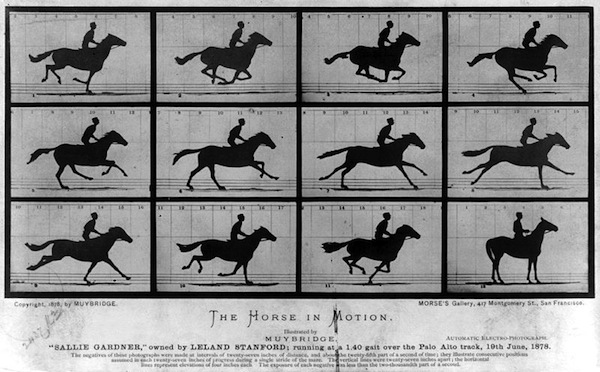Author
[email protected] [email protected]
Date published
April 9, 2012
Categories

A Google Doodle today is paying tribute to motion picture innovator Eadweard J. Muybridge, a man whose 1878 series of photos known as “The Horse in Motion” was a precursor to motion pictures, television, and video-sharing sites such as YouTube.
Google’s “Horse in Motion” Doodle appears as a strip of photos until you click a yellow play button. That puts the horse in motion on what seems to be an endless loop until you click on Google’s logo and you’re brought to a search results page for [Eadweard J. Muybridge].
Google’s animated logo adds some Google-y colors to the original black and white photos, which were captured using a series of trackside cameras set up parallel to a galloping racehorse.

Muybridge’s status as “father” of the motion picture came about not with some great futuristic vision. Rather, the goal was to settle an argument about whether all four of a horse’s hooves are ever off the ground at the same time while trotting.
Starting in 1872, Muybridge set out to scientifically provide an answer at the urging of Leland Stanford, the former California governor and racehorse owner. His attempts were interrupted by an 1874 murder trial in San Francisco, California, when Muybridge was accused of killing his wife’s lover – he was acquitted for “justifiable homicide.”
Muybridge’s images proved that yes, all four horse hooves can leave the ground at the same time, though not in the way artists had depicted it at the time.
Muybridge, who was born on this date in 1830, is also known for inventing the zoopraxiscope, one of the earliest devices to display motion pictures – a forerunner of movie projectors that inspired Thom Edison’s pursuits of developing a motion picture device, which became the kinetoscope. (The motion picture camera also appeared in a Thomas Edison Google Doodle in February 2011.)
Born in Kingston upon Thames, England, he moved to San Francisco, California, in 1855. He took up photography in the 1860s, initially focusing on landscapes and architecture.
In the mid-1880s, Muybridge continued to study the movement of animals as well as nude or mostly nude people using stop-frame photography, eventually publishing a collection of 20,000 pictures in a study called “Animal Locomotion”. Muybridge returned home to England in 1894, where he wrote and published a pair of books on his work prior to his death May 8, 1904.

